It’s not just your looks that change as you age. That brand-new, vibrant, and perfect-looking tattoo you just got will also fade and look old as the years go by. But it doesn’t mean you should just sit back and wait for mother nature to take its toll on your tattoo. With proper tattoo aftercare and maintenance, you can actually make your tattoo look good for years – maybe even forever!
Page Contents
- Why should you take tattoo aftercare seriously?
- Your Tattoo Aftercare Calendar
- New Tattoo Care FAQs
- Conclusion
Why should you take tattoo aftercare seriously?
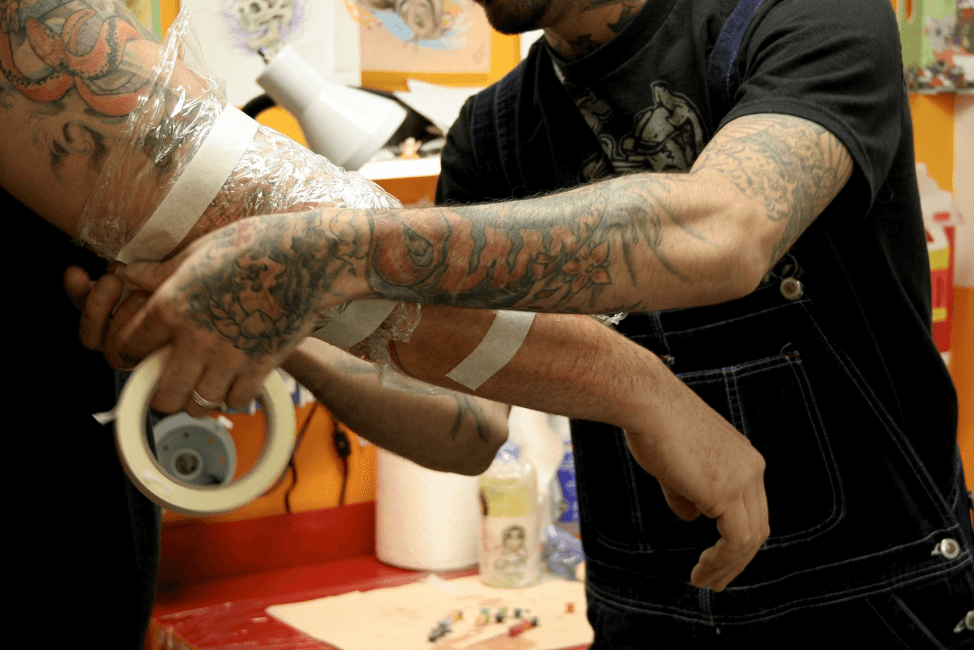
Your tattoo aftercare journey begins right this very moment (Photo by Angie Torres)
Tattoos involve not just money and time, but also blood, sweat and tears – literally! It’s a commitment that starts from the moment the needle (or group of needles) pricks your skin. And that commitment lasts throughout your lifetime; unless, of course, you regret your decision later and get it laser removed.
Technically, tattooing is a medical procedure, even though most tattooists have no medical training to speak of. The way tattooing works is that skin is pricked by needles to create small openings in the skin. Tattoo ink is then deposited in these tiny puncture wounds.
Without proper aftercare, your brand-new tattoo is at risk of becoming infected. You may experience redness, irritation and swelling around the area. For more severe tattoo infections, you’ll notice pus and a foul odour along with pain and high fever.
Serious infections can lead to a prolonged stay in hospital. In worst case scenarios, death is a likely possibility. So, for best results, follow your tattooist’s aftercare instructions. They care about you – you’re walking proof of their talent!
Your Tattoo Aftercare Calendar
This aftercare calendar is designed to help you figure out what you need to do for each stage of the healing process. However, we all heal at different rates, so this guide isn’t written in stone. Feel free to adapt according to your body’s healing rate.
But first, before we proceed, here’s an infographic summarising the tattoo aftercare process:
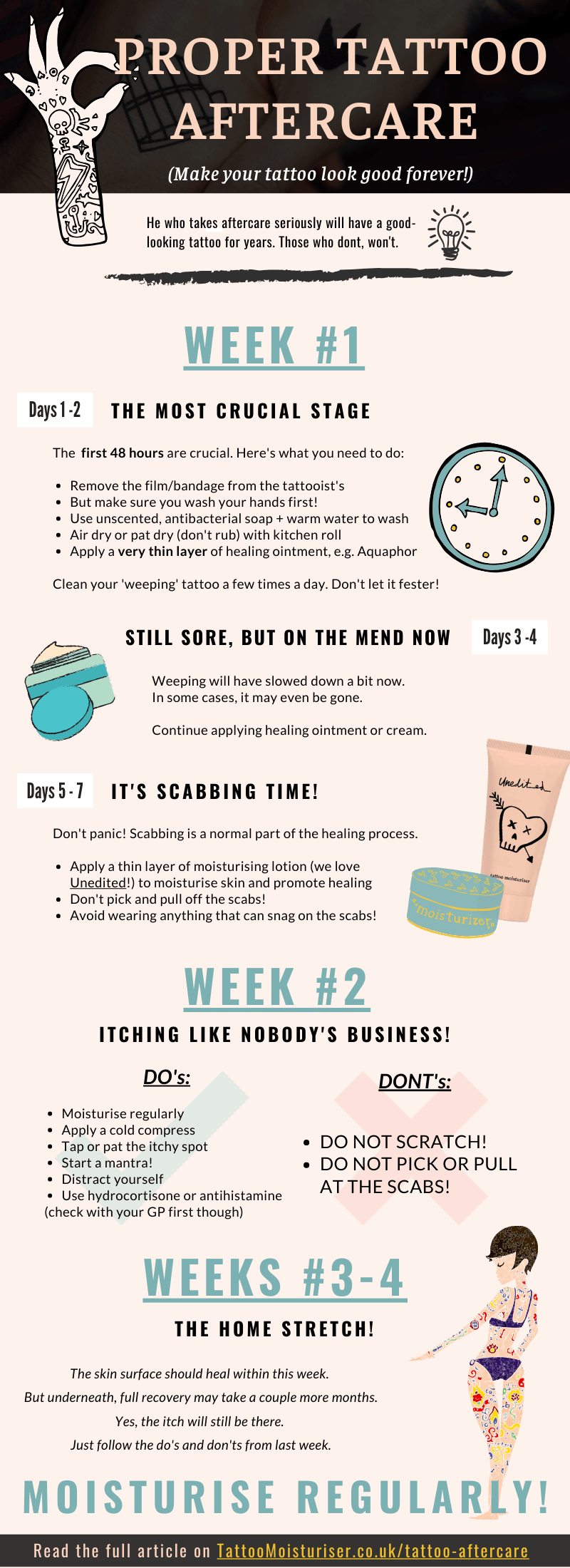
Days 1-2: The Most Crucial Stage Of The Healing Process
In tattoo aftercare, the first 48 hours are crucial. So, right after your tattoo is done, your tattooist will clean and disinfect the area (they usually use green soap in the studio), before wrapping it up in clear plastic film. This is done to protect your tattoo as you make your way home from the studio.
Step 1: Remove bandage
Most tattooists will tell their clients to remove the bandage after a couple of hours. This is because, by this time, blood, plasma and ink will have formed a mess on your skin. Remove the bandage carefully and dispose of it properly.
Step 2: Wash your hands
Before touching your tattoo, make sure you wash your hands first. You don’t want dirt to get on your tattoo at this point.
Step 3: Wash your tattoo with your bare hands
It’s important to use your hands to wash your tattoo. Never use shower accessories like sponges, loofahs or washcloths as bacteria thrives in these things!
Use unscented, antibacterial soap and warm water to wash your tattoo. Avoid soap that has alcohol and artificial fragrance, as these can ‘burn’ and dry out the area. Check our list of the best tattoo soaps you can use to wash your new tattoo with.
Note: Some tattooists say using hot water (the max temperature you can withstand) is better for rinsing off the gooey mess on your skin. Others will tell you to use lukewarm water. Listen to what your tattooist tells you.
You will need to wash your tattoo every few hours to keep the wound clean. You don’t want too much plasma sticking to the skin as doing so can result in thick, unsightly scabs later on.
Step 4: Dry your skin
After washing, air dry your skin or pat it dry (don’t rub) with a few kitchen rolls. Towels are also not advisable (even fresh ones) as loose thread and fabric can stick to your wound and cause an infection.
Step 5: Apply healing ointment
Up next on your to-do list is to apply a very thin layer of healing ointment like Aquaphor or A+D. These ointments are both petroleum-based, but won’t block oxygen from entering your skin. It acts as a protective barrier and promotes healing underneath the skin at the same time.
Here’s an infographic of how an ointment like Aquaphor works:
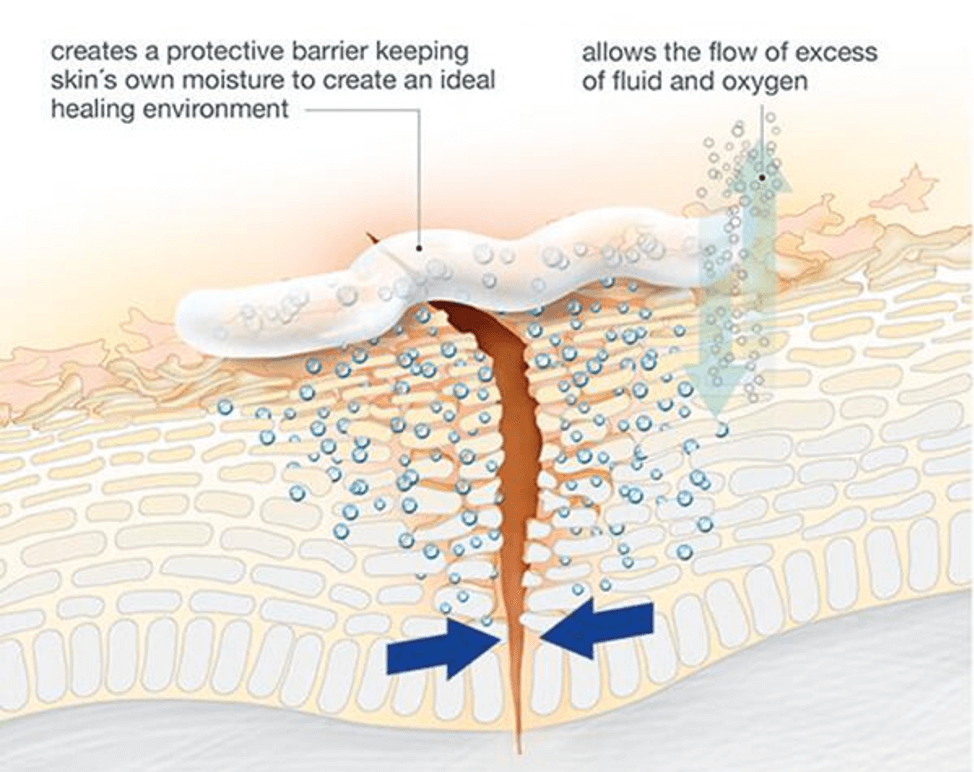
Image source: https://www.aquaphorus.com/how-it-works/
As you can see in the image above, it’s important for the area to be dry and clean. Otherwise, water/moisture can get trapped underneath the ointment which can irritate and cause the skin to swell up.
Now, if you’re not a fan of petroleum-based products, a couple of good vegan alternatives you may want to consider are Hustle Butter Deluxe and Butter Up Rich Body Butter. These may be a bit pricey (most natural and vegan products are), but will work wonders for your skin!
Step 6: Repeat steps 2-5 three or four times a day
You’ll feel icky if you don’t. Your tattoo will continuously weep or ooze during the first 48 hours or so. You’ll need to clean it up, otherwise, you’re opening your new tatt to a world of infection.
First day tattoo care is not going to be fun at all. In fact, the first couple of days are going to be rough – you’ll experience redness, swelling, and some pain. But hang in there! There’s always light at the end of the proverbial tunnel – you’ll see yours soon enough!
New tattoo sleeping woes: how to sleep with a fresh tattoo?
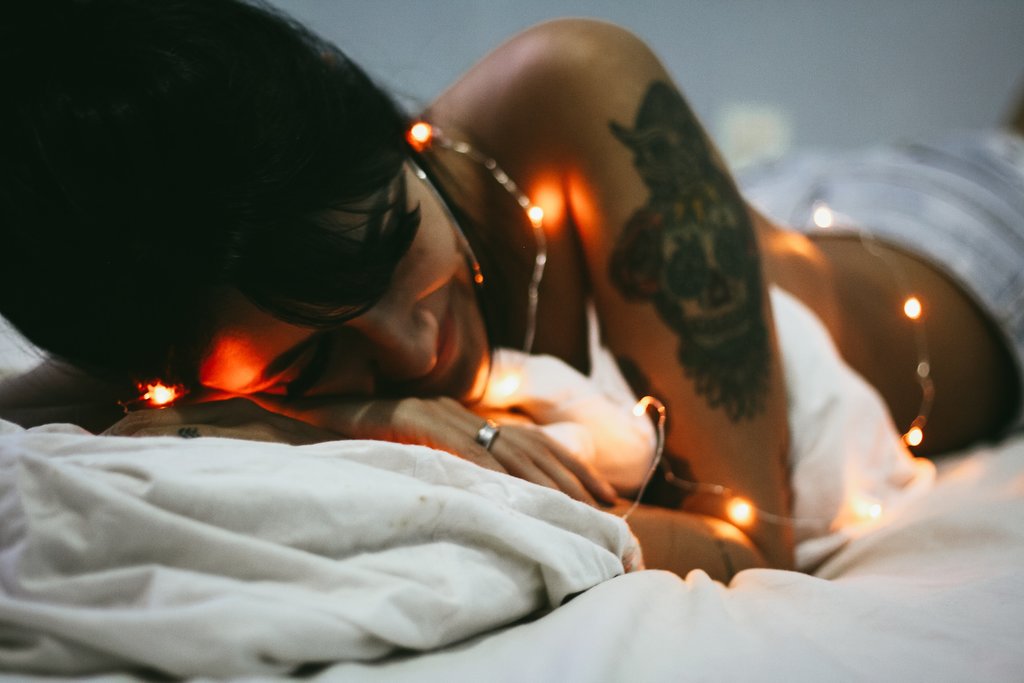
Take extra precautions to protect your tattoo when you go to bed (Photo by Matheus Ferrero)
There’s no two ways about it – sleeping with a brand-new tattoo is going to be tough. Even if you only had a tiny one done, you’ll still feel some discomfort when you go to bed. It will be painful and sore, and you need to be very careful about not letting anything touch your tattoo! The healing ointment can only offer so much protection, after all.
That said, here are some tips to help make your first couple of nights more comfortable:
- Re-wrap in cling film
If you got your tattoo late at night and you’re just about ready to fall asleep when you get home, then it’s fine to sleep with the cling film from the shop (please consult with your tattooist first though).
But if you’ve had it done earlier in the day, then you may want to wrap your wound in a fresh roll of plastic film to protect it from the dust and germs in your bed. Of course, when you re-wrap, make sure NONE of what you’re trying to keep out actually gets trapped within the film (it defeats the purpose of re-wrapping)!
- Use clean beddings
Some tattooists advise against re-wrapping tattoos during the night. They say it’s better to just sleep in a clean bed, so your skin can breathe whilst you sleep. The healing ointment should be good enough protection for your tattoo.
Since your wound will likely be ‘weeping’ all night long, it’s best to use some old but clean beddings. If you wake up in the morning and find the sheet sticking to your tattoo, proceed with caution.
Don’t pull the sheet away as doing so can also pull some ink out! Instead, bring the sheet with you to the shower or sink, and run some lukewarm water over it until the sheet separates from your skin.
- Don’t sleep on your new tattoo
This is common sense, but when you’re asleep, you likely won’t realise you’ve slept on your tattoo until you feel it in the morning. Sleeping on your tattoo can aggravate and irritate the wound, and possibly even start an infection.
To avoid accidents of this sort, find a sleeping spot where you don’t possibly end up lying on top of your still-very-much-bruised skin. Let your partner know as well, so they can watch out for you, too.
Taking a shower with a new tattoo

Don’t soak your new tattoo! (Photo by Naomi August)
Taking a long leisurely bath may sound like a good idea, but not when your tattoo’s still very much unhealed. Dirt and grime get trapped in the tub. It’s the perfect place for bacteria and germs to come together and infiltrate your wound like invisible ink-destroying ninjas.
Take a quick shower instead (emphasis on ‘quick’). Just enough to feel clean and not soak the tattoo at the same time. If your fragranced soap or shampoo gets in the tattoo, just rinse it off.
After you shower, dry yourself as you normally would but take special care with the still-tender area. Don’t use your towel to dry up your tattoo. Instead, get a few sheets of kitchen roll and pat the area dry, then put on a fresh layer of Aquaphor… or whatever your favourite healing ointment is.
Days 3-4: Your tattoo is on the mend, but still very much sore
The soreness will depend on how big the tattoo is and where it’s located. But generally, most people start feeling a bit better now that the weeping has slowed down a bit. It’s highly likely you’ll still see bits and blobs of lymphatic fluid along with some ink – all completely normal!
At this point, the swelling and the pain should also have gone down a bit. You may even continue to see some light scabs starting to form on the area. If so, then that’s a good sign!
What you need to do:
Continue applying healing ointment or cream on the tattoo. Do this until your tattoo stops oozing.
Days 5-7: It’s the scabs time to shine!
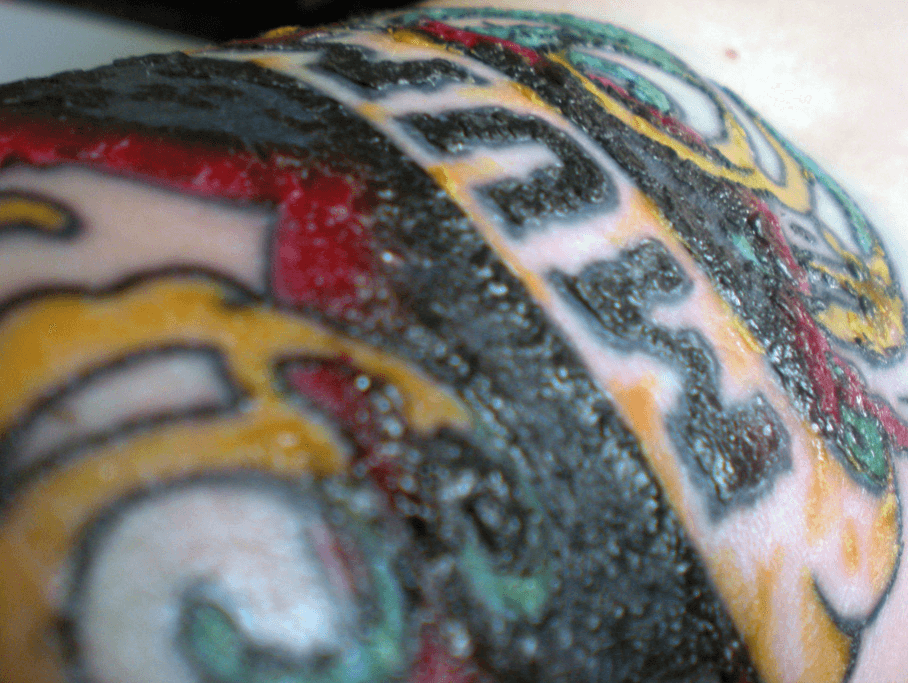
Scabbing is normal, but don’t let it get it this thick! (Photo by Kim Laurenson)
If you followed our advice and cleaned up your tattoo really well, then your scabs should be crusting quite nicely now. It shouldn’t be too thick. Just thick enough to cover the tattoo and protect it from debris and bacteria, whilst the healing goes on underneath.
Don’t be scared if you think if your tattoo looks ugly, cloudy and dull right now. It’s all pretty normal. And just so you know, it may look even uglier once it starts peeling and flaking off.
If you experience heavy scabbing (think extra crusty, multi-layered, extra-large scabs) even if you carefully followed tattoo aftercare instructions, then you may have a problem. It’s either your tattooist was too heavy-handed and did tremendous damage to the skin, or you’ve developed an infection.
If it’s the former, there’s not much you can do, but to continue with the aftercare program. If it’s the latter and you’re experiencing other tattoo infection symptoms, please speak with your GP straight away.
Also, it’s important to mention that some tattoos don’t even scab at all. This usually happens with tiny, fine tattoos done by highly skilled tattooists. Or, even tattoos that use white ink. So, if you don’t go through this stage, then hurray for you!
What you need to do (and not do):
So, back to scabbing.
- For normal scabs, apply a very thin layer of moisturising lotion to your tattoo to keep the skin well-hydrated, so it can continue to heal properly. The key word here is ‘thin.’ A thick application will cause your scabs to get soggy and can slog off prematurely, pulling ink out in the process. Plus, it will delay the healing process as well.
- For giant, non-normal scabs, avoid putting on lotion on it. Instead, apply lotion to the area surrounding the scab. This way, the scab will dry up naturally and will eventually fall off on its own.
- The scabs will be an eyesore and will cover up your tattoo. But don’t get tempted to pick and pull it off prematurely! If you do, then you may see some ink getting pulled out along with the scabs!
- For scabs that look just about ready to fall off, leave them be as well. If there’s a possibility of that scab getting snagged on clothing, furniture or whatever, then cover up the scab with something to protect it.
- Avoid wearing tight clothing as the scabs can easily get caught and pulled off.
Week 2: Don’t go bitchin’ ‘bout the itchin’!
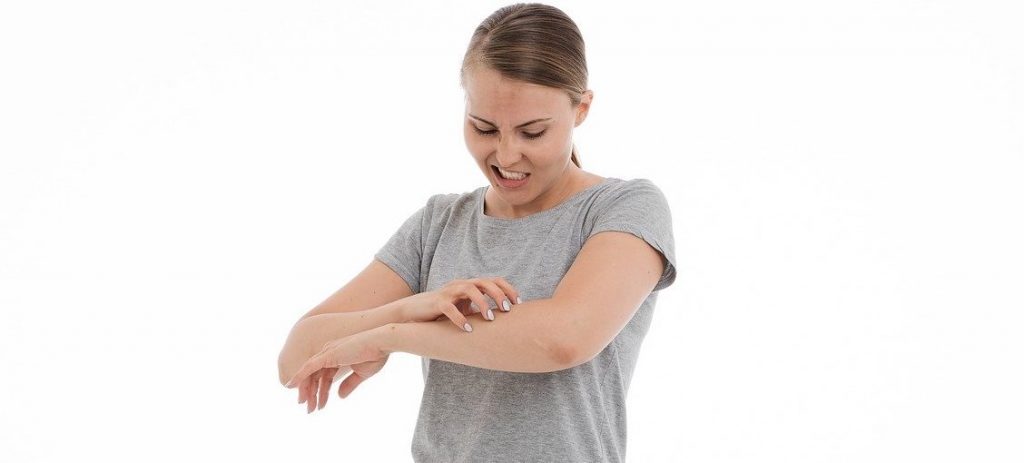
Resist the itch of a healing tattoo! (Photo by Анастасия Гепп)
Warning: Fun times ahead…. NOT! You probably got a taste last week when the scabs were forming, but now that they’re starting to fall off, you’ll experience a different level of ITCHING!
If you’ve ever been wounded before, you know it starts getting really itchy once it gets to this point! So, what happens at this stage is that your scabs mature and fall off on their own, which exposes the newly generated epidermis skin layer to the outside world. This essentially means the puncture wounds you got at your tattooist’s hands are all closed up now.
Unfortunately, the downside to all this skin renewal and wound healing is that your skin will end up being very dry. This leads to flaking and peeling, pretty much like a sunburn.
Note:
If you have an underlying skin condition like eczema or dermatitis, then your itch won’t just be on another level, it will be on another planet altogether! If you think your tattoo is itching like nobody’s business, and you’ve got rashes or skin bumps to go along with the itch, then a visit to the dermatologist may be needed.
What to do (and what to avoid):
No matter how bad your tattoo itches, Do. Not. Scratch. Please. If you do, your fingernails are going to catch some of that skin and pull it out prematurely. Chances are it’s going to take some of that precious ink with it and you’ll end up with a patchy tatt.
Dealing with the itch will take supreme self-awareness and discipline. If you’ve got loads of these, then good for you! However, for most regular folks, try out these tips and tricks. Some of these (hopefully all!) will work and save you from going crazy!
- Apply a thin layer of moisturising lotion
If you followed our aftercare advice for last week, i.e. after your tattoo stops oozing, you can just continue using the same kind of lotion to moisturise your skin. Aveeno, Lubriderm, Cetaphil and other similar brands sell moisturising lotions that work great on newly-healed tattoos.
- Apply a cold compress
Only follow this tip if you’re absolutely sure your skin’s top layer has healed. Otherwise, germs and bacteria from the compress can enter your skin and cause an infection. That said, cold compresses are great for providing near-instant itch relief. The cold will also restrict blood flow to the area, which helps reduce swelling.
- Tap or pat it instead
Some people swear tapping or patting the itchy area works. Others tend to favour a bit more force and say slapping is more effective. Either way, the sting will take away some of the itch. In a brief instant, you’ll find some temporary relief.
- Start a mantra
Mantras work if you truly believe in what you’re saying. Say something like ‘I’m strong, I can resist the itch. The itch is nothing. Mind over matter.’ Or, something to that effect. Every time you feel like giving in, close your eyes and mutter your mantra out loud or privately in your head. You’ll feel better after, I promise.
- Get a hobby
Hobbies are nice, they’re distracting and entertaining at the same time – two things you need at this itchy stage of your life. So, if you haven’t got a hobby yet, now’s the time to get started.
- Work on something very important
Got a work deadline coming up? Well, you may still be sore from last week’s tattoo session. But don’t let that stop you from working on important tasks that will take your mind away from your itchy present!
- Use hydrocortisone
If you’ve tried all of the above and the itch is still unbearable, then try applying a thin layer of hydrocortisone 1% anti-itch cream or ointment. But again, make sure your skin’s top layer is fully healed before putting this on. Fortunately, you can buy this at most chemists and supermarkets, so you should find sweet relief any minute now!
Weeks 3-4: The home stretch

This woman’s photos look pretty well-healed (Photo by Annie Spratt)
Just a couple more weeks and your tattoo will finally be healed. At the beginning of week 3, it’s just the skin surface that’s recovered, but underneath, it’s still a work in progress. Don’t worry though, it will all be healed up soon – some may take up to a couple of months though, especially for larger tattoos.
What to expect?
Of course, the ever-persistent itch will still be present, but with the coping techniques you’ve learned in the previous week, it should be more manageable now. Also, the swelling should have subsided at this point, and there should be no more raised or bumpy sections on your tattooed skin.
Washing and cleaning your tattoo need not be as often as it was in the early days. At this stage, you can wash your tatt when you take a shower. The needle puncture wounds may have healed, but it’s best to stay safe and just clean the tattoo periodically.
Your skin will still be dry with all the flaking and peeling going on. But, over time, this will eventually stop until a fresh layer of epidermis skin cells are all that’s left. You’ll still need to moisturise once or twice a day (depending on your lotion’s formulation). In fact, you’ll need to moisturise every single day – if you want your tattoo to look good for years!
Week 5 and beyond: Long-term tattoo maintenance tips
Congratulations! Your tattoo is now fully healed and you can now go back to living life normally (albeit with a few more precautions to preserve your tatt). So, here are some long-term aftercare tips to make your skin art last forever!
Tip #1: Hydrate and drink water
Your tattoo can only look as good as the skin it’s on. Dehydrated skin looks dry and dull. Make drinking water (not soda) a habit. Drink at least 8 glasses of water a day. You can download an app on your phone to help you track how much water you’re drinking per day.
Drink Water Reminder N Tracker is a good example. Here’s a screenshot:
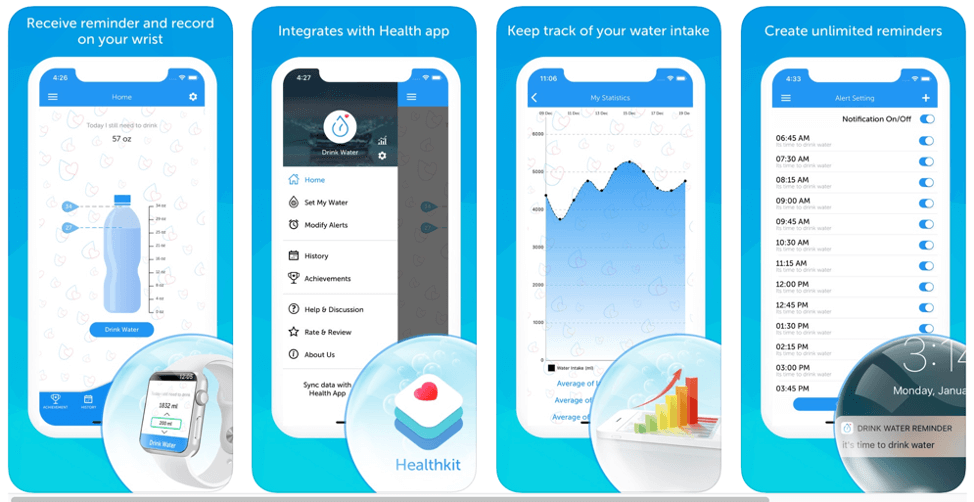
Tip #2: Eat healthy food
Junk food’s irresistible sometimes. And really, it’s okay to eat some every once in a while, just don’t make it a daily thing. Otherwise, your body – and your skin specifically – can suffer.
That said, if you want your skin to glow, eat foods rich in antioxidants. Here’s a list of superfoods that will not only give your skin a much-needed boost, but will also help improve your immune system:
- Grapes
- Blueberries
- Red berries like strawberries and raspberries
- Nuts like almonds, walnuts, peanuts, cashew and pistachios
- Dark green veggies like broccoli, kale, spinach, and lettuce
- Sweet potatoes
- Orange vegetables like carrots and squash
- Green tea
- Whole grains like brown rice, oatmeal, whole-wheat bread and pasta
- Beans like lentils, green soybeans, black-eyed peas and soy
- Fish like salmon, sardines, tuna, mackerel and herring
Tip #3: Moisturise skin
Once you get a tattoo, you’ll need to moisturise it forever. It’s a lifelong commitment, otherwise, your tattoo can dry up. And before you know it, it’ll look old, faded and wrinkled. For long-term maintenance, any daily moisturising lotion should do the job.
Tip #4: Protect it from the sun
If you don’t want your tattoo to look weathered like an old sailor’s tattoo, then you best apply sunblock every single time you go out into the sun. You may think it’s extreme, but it’s necessary protection for your tattoo. The sun’s ultraviolet rays can still do damage to old tattoos. It will break down the ink trapped in the dermis, which will make your tattoo look faded.
We like Banana Boat’s SPF50+ sunscreen. It’s non-greasy and the spray bottle makes it very convenient to use. It’s water-resistant too, so even if you go swimming out in the heat, it will protect your tattoo – and your skin – from the harmful rays of the sun!
Another option would be to wear sun-protective clothing. Choose fabric that is woven or knit tightly as this prevents UV rays from reaching the skin. Wool, silk, denim, nylon and polyester are good examples. Also, keep in mind that darker fabrics absorb more UV rays than lighter ones.
A tattoo sleeve cover like you see below will work wonders for you if you’re the active kind and you like spending time in the sun.
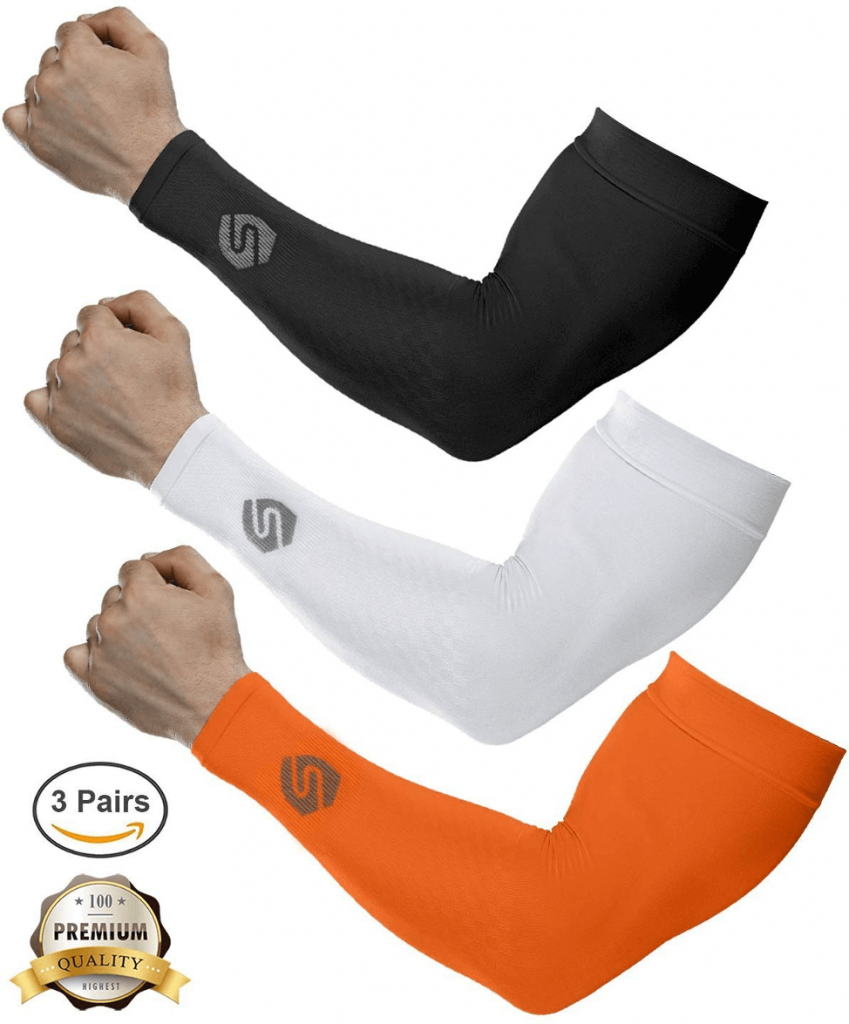
You can buy Shinymod’s cooling sun sleeves on Amazon
Tip #5: Weight watch
Oh, yes, weight fluctuations will have an effect on tattoos. Weight gain will cause your skin to stretch out, thus making your tattoo appear stretched out as well. Weight loss, on the other hand, will make your skin wrinkled which will obviously distort your tattoo.
This is why pregnant women – or those who are attempting to become one – should hold off on getting a tattoo until much later. Perhaps until they’ve weaned their baby or they’ve lost the excess pregnancy weight.
Tip #6: Avoid getting cut in tattooed area
Tiny cuts and scrapes on the surface shouldn’t do anything to your tattoo. But if the injury occurs in the dermis layer, then the tattoo will be affected. In some cases, scar tissue may appear on your tattoo, which will distort its appearance. For cuts that go down into the dermis, treat it like you would a new tattoo so as not to cause further cosmetic damage.
New Tattoo Care FAQs

Don’t be afraid to ask questions (Photo by Jon Tyson)
Alright, so I’ve drawn up the answers to the most frequently asked questions about tattoo aftercare.
1. When can I go swimming?
Swimmers and surfers are going to hate this part, but you need to wait… possibly up to 2-4 weeks after getting the tattoo. Even if your tattoo’s already past the scabbing stage, it’s still best to wait and ensure the skin’s natural barrier has been fully restored. You can take quick showers, but that’s about it. Soaking your tatt in tubs, pools, lakes, and the ocean should be avoided for as long as necessary.
Read this article: How Bathing and Swimming With A New Tattoo Works
2. What about working? Can I go to work if my tattoo’s still fresh?
Preferably, you should get your tattoo on your rest day from work, or perhaps while you’re on holiday. You’ll be subjected to thousands of tiny needle pricks; you surely deserve rest afterwards.
But, in the unfortunate event you can’t get some time off work, protect your tattoo at all costs. Make sure you clean the area and apply ointment to protect it. If your work clothes will be rubbing against your tatt, put on some clean bandage (but ensure it doesn’t cut off oxygen from reaching your skin).
3. Is coconut oil okay for tattoos?
I’m a huge coconut oil fan. But even so, I won’t suggest rubbing some on a still-weeping tattoo. This is because coconut oil is said to have ‘pulling’ properties which may pull ink out of your skin.
It’s best to apply the aftercare lotion made with coconut oil once the tattoo is dry and no longer weeping. This usually happens 24-48 hours after getting inked (depends on your body’s healing rate).
4. Is it okay to get some exercise after getting tattooed?
Well, no, not right after. But unlike swimming, which will take weeks before your tattoo’s safe for submerging, you only need to wait 48 hours! So, that’s great news for gym bunnies who are addicted to working out!
Bad news is, if your tattoo is somewhere more private, you’ll need to hold off on the whole exercise thing until your tatt is fully healed (about 3-4 weeks or thereabouts).
5. How to take care of my colour tattoo?
Colour tattoo care instructions are basically the same as more traditional all-black tattoos. Scroll back up to know all about how to take care of a brand-new colour tattoo!
6. When can I shave again?
This is obviously one of the things you can’t do after getting a tattoo. But as soon as it’s fully healed, you can shave again. Hair that’s growing back is itchy, so you’ve got your job cut out for you with an itchy, healing tattoo as well.
Conclusion
Your tattoo’s aftercare journey starts from the moment you leave the tattooist’s shop. Follow your tattooist’s instructions on how to care for your fresh tattoo. The entire month after getting your tattoo is important to long-term success, but the first 48 hours are absolutely crucial. Take to heart the do’s and don’ts of post-tattoo care and your skin art will look good for years, possibly even forever!

Thanks for all the tips!!
Many thanks best aftercare article I have found by a long way.